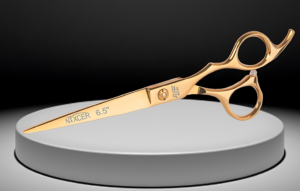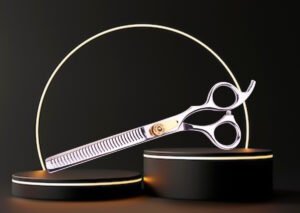Avoiding split ends is crucial for maintaining healthy, vibrant hair, and one of the key factors in preventing them is using high-quality hair cutting scissors. Split ends occur when the hair shaft becomes damaged, usually due to friction, heat, or blunt cutting tools that fray the ends of the hair. High-quality scissors, designed specifically for hair cutting, can make a significant difference in keeping your hair smooth and free from split ends.
Here’s a detailed guide on how to avoid split ends using high-quality hair cutting scissors.
1. Invest in Professional-Grade Scissors
The first step to avoiding split ends is to use professional-grade scissors specifically designed for hair cutting. Here’s why.
Sharp Blades: High-quality scissors have razor-sharp convex or beveled edges that slice through hair cleanly. This prevents the fraying that can occur with dull blades, which tend to crush or bend the hair fibers, leading to split ends.
Precision Cuts: Professional scissors provide precision and control, allowing you to make clean, smooth cuts that seal the hair ends rather than fraying them.
Durable Materials: Quality Professional hair cutting scissors are made from high-grade stainless steel or cobalt alloys, which retain sharpness longer and resist corrosion, ensuring a consistent, clean cut every time.
2. Use the Right Type of Scissors for the Job
Different scissors are suited for different types of cuts, and using the wrong scissors can contribute to split ends.
Convex Edge Scissors: These are ideal for clean, precise cuts. The ultra-sharp edge minimizes friction, reducing the risk of damage to the hair ends.
Texturizing or Thinning Scissors: If layering or adding texture, use texturizing scissors specifically designed for those purposes. Avoid using regular cutting scissors for thinning, as this can cause uneven cuts and increase the likelihood of split ends.
Avoid Household Scissors: Never use household or craft scissors for cutting hair. These scissors are not designed for hair cutting and can cause significant damage to the hair shaft, leading to split ends.
3. Regular Maintenance of Scissors
Maintaining your scissors is crucial for avoiding split ends. Even high-quality scissors can cause damage if not properly cared for.
Clean After Each Use: Wipe your scissors with a soft, dry cloth after each haircut to remove hair, oil, and debris. Clean scissors maintain their sharpness and cutting precision.
Disinfect and Lubricate: Regularly disinfect your scissors and apply scissor oil to keep the blades operating smoothly. Lubrication reduces friction between the blades, ensuring a clean, crisp cut.
Sharpen Scissors Regularly: Even the best scissors need regular sharpening to maintain their effectiveness. Dull blades can tug and tear at the hair, creating jagged cuts that lead to split ends. Have your scissors professionally sharpened as needed to keep them in top condition.
4. Adjust Tension Properly
Proper tension adjustment on your scissors plays a critical role in preventing split ends.
Check the Tension Regularly: If the tension is too loose, the blades will fold hair instead of cutting cleanly, which can cause split ends. If the tension is too tight, it can damage the scissors and make cutting uncomfortable.
Adjust as Needed: Most professional scissors have an adjustable screw or knob to set the tension. Adjust the tension so that the scissors close smoothly but with enough resistance to cut through hair effortlessly.
5. Use the Right Cutting Technique
The technique you use when cutting hair is just as important as the scissors themselves.
Cut in Small Sections: Cutting hair in small sections gives you better control and allows for cleaner, more precise cuts. This reduces the risk of accidentally nicking or tearing hair strands.
Avoid Sliding Cuts: Sliding cuts, where the scissors are pulled along the hair shaft, can cause damage if not done correctly. If you need to slide cut, make sure you use scissors specifically designed for that purpose, and employ the correct technique to avoid split ends.
Point Cutting: When point cutting to create texture, ensure that your scissors are sharp enough to avoid fraying the ends. Point cutting with dull scissors can create micro-tears in the hair shaft, leading to split ends over time.
6. Regular Trims
Even with the best scissors and techniques, regular trims are essential to prevent split ends from progressing.
Schedule Trims Every 6-8 Weeks: Regular trims keep the hair ends healthy and prevent split ends from traveling up the hair shaft, which can cause more extensive damage.
Micro-Trimming: For those looking to maintain length, micro-trimming (cutting off just a tiny amount) can help maintain healthy hair while removing split ends.
7. Store Scissors Properly
Proper storage of your scissors protects their blades and ensures they remain effective.
Use a Protective Case: Store your scissors in a dedicated case or pouch when not in use to protect the blades from nicks, moisture, and dust.
Avoid Dropping: Dropping scissors can damage the blades, misalign the pivot, and affect their sharpness, leading to poor cuts that can cause split ends.
8. Avoid Cutting Wet Hair with Dry-Cutting Scissors
Using scissors designed for dry cutting on wet hair can dull the blades more quickly, leading to rough cuts.
Use Scissors Appropriately: If you need to cut wet hair, ensure your scissors are suitable for wet cutting to maintain their sharpness and effectiveness.
Final Thoughts
Avoiding split ends with high-quality hair cutting scissors comes down to selecting the right tools, maintaining them well, and using proper cutting techniques. Investing in professional-grade scissors and caring for them properly will not only enhance your haircuts but also keep your hair healthy, vibrant, and free from split ends. Regular trims, correct tension, and precise cutting are all key components in ensuring your scissors work for you, not against you, in the battle against split ends.



